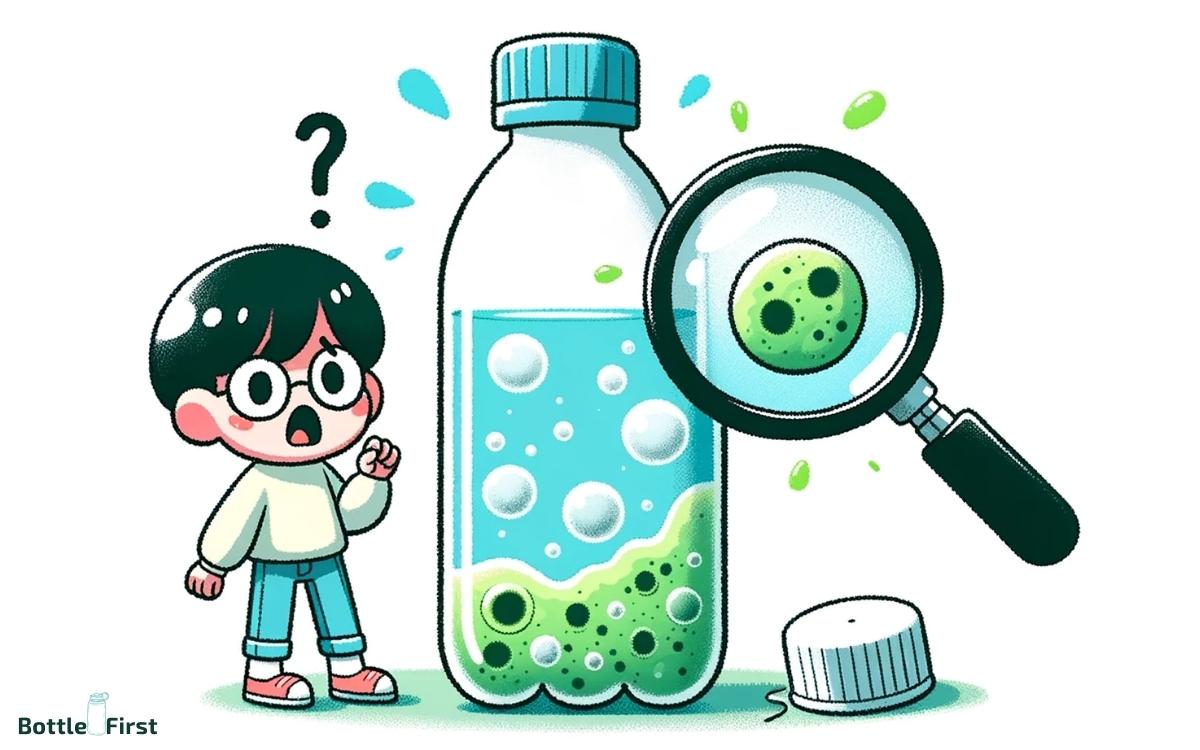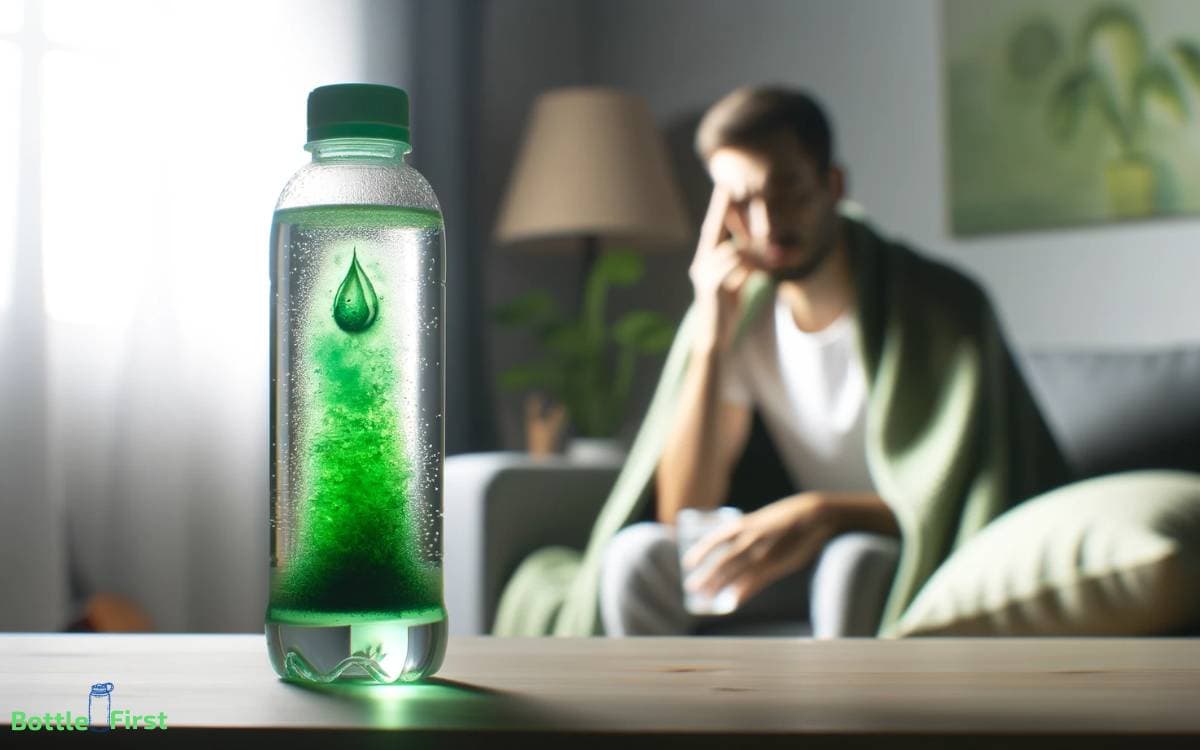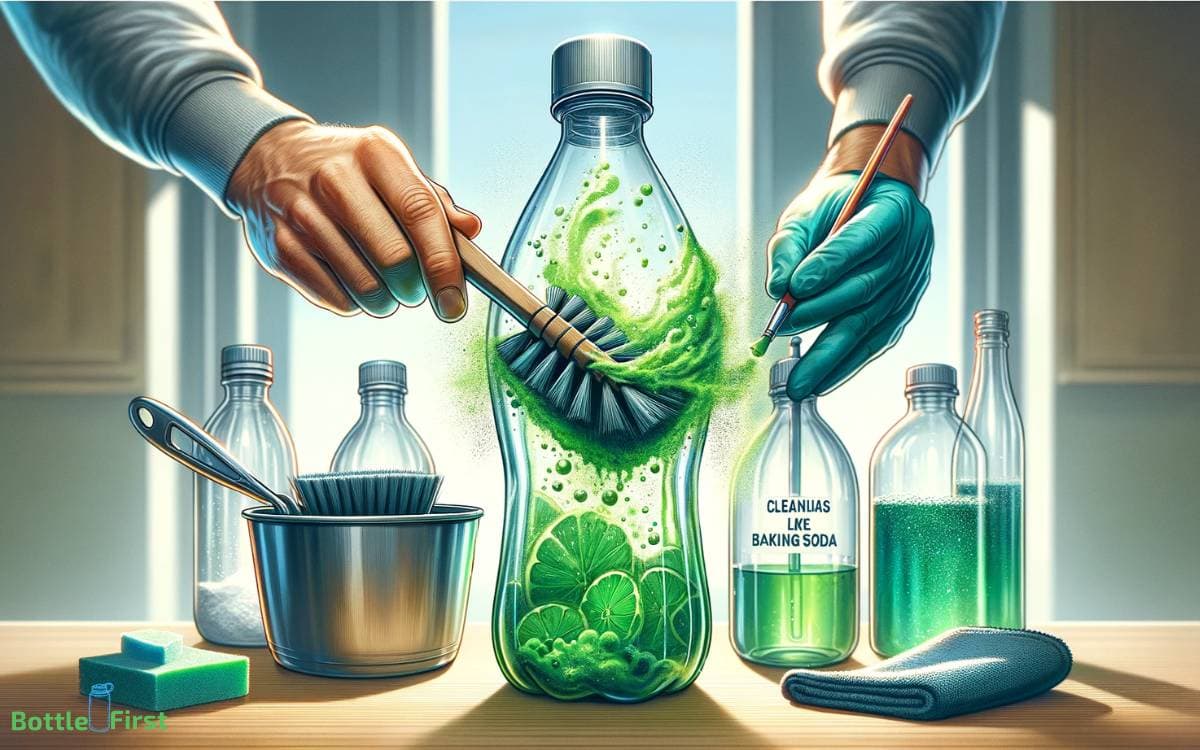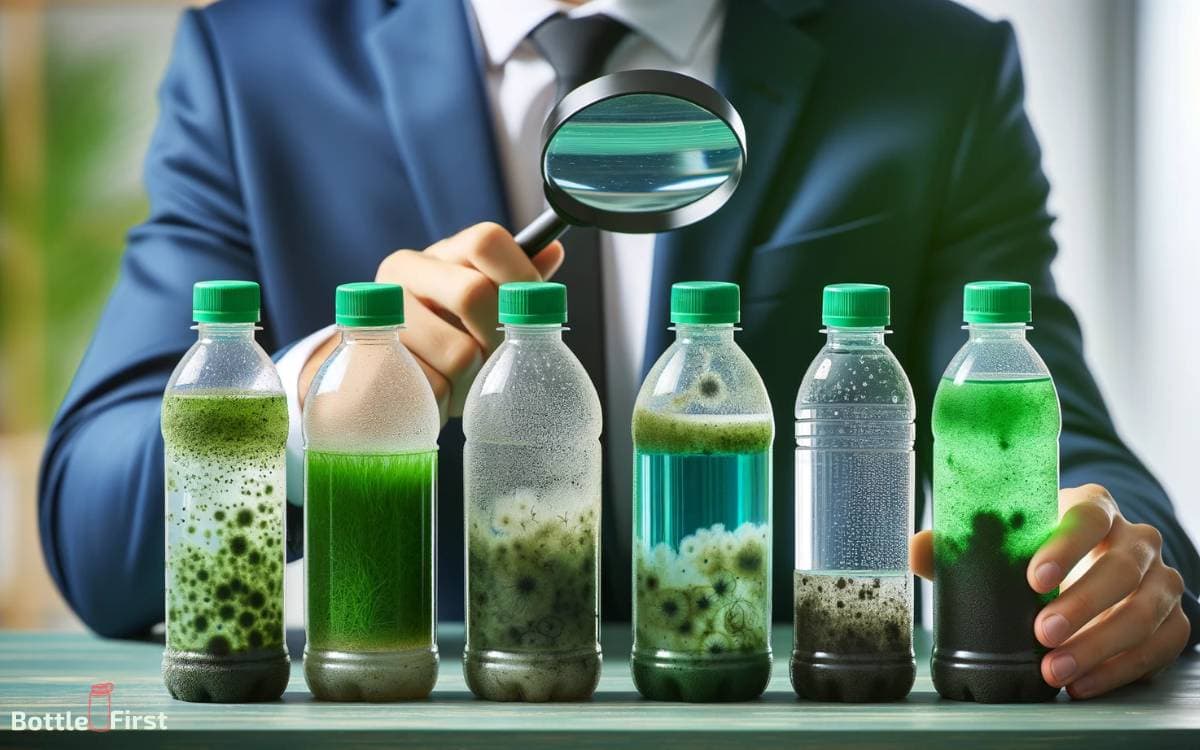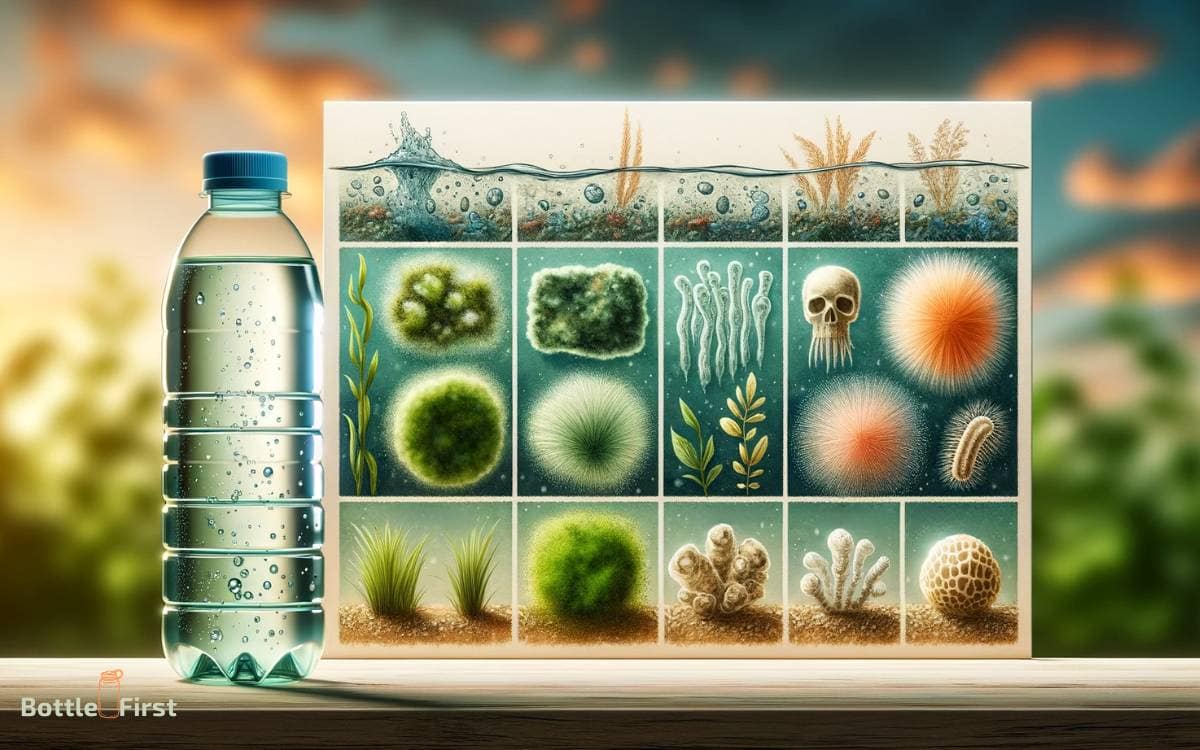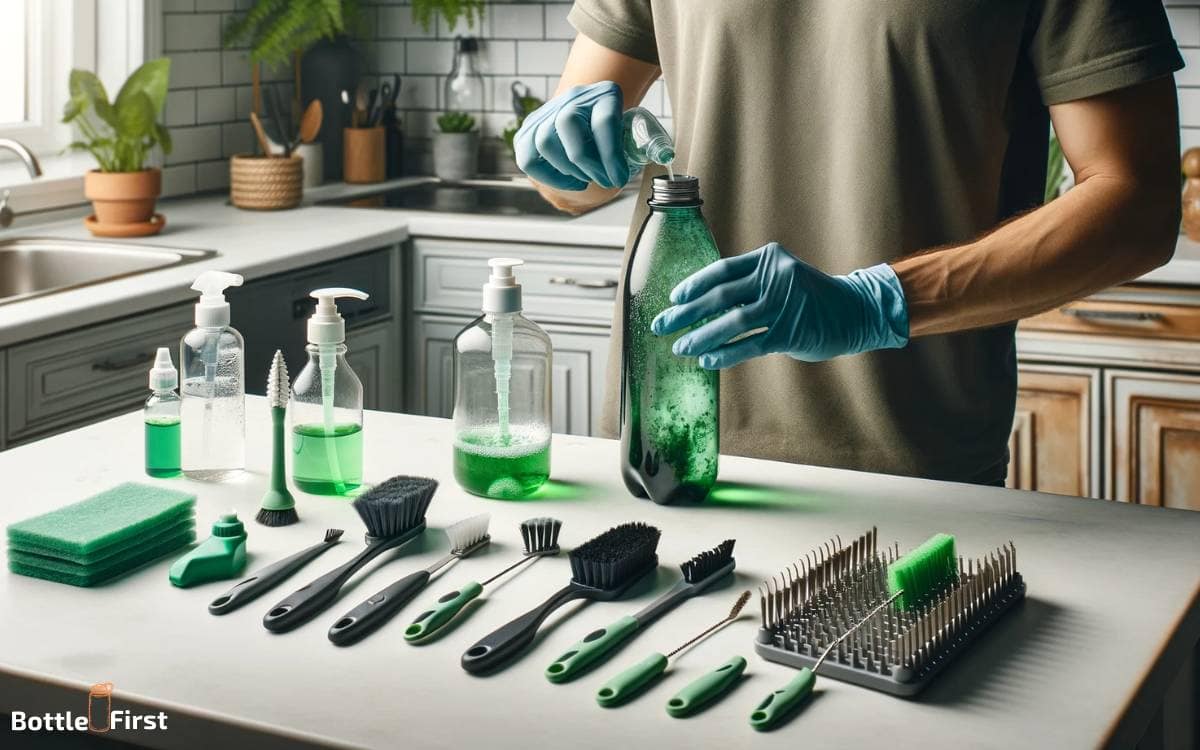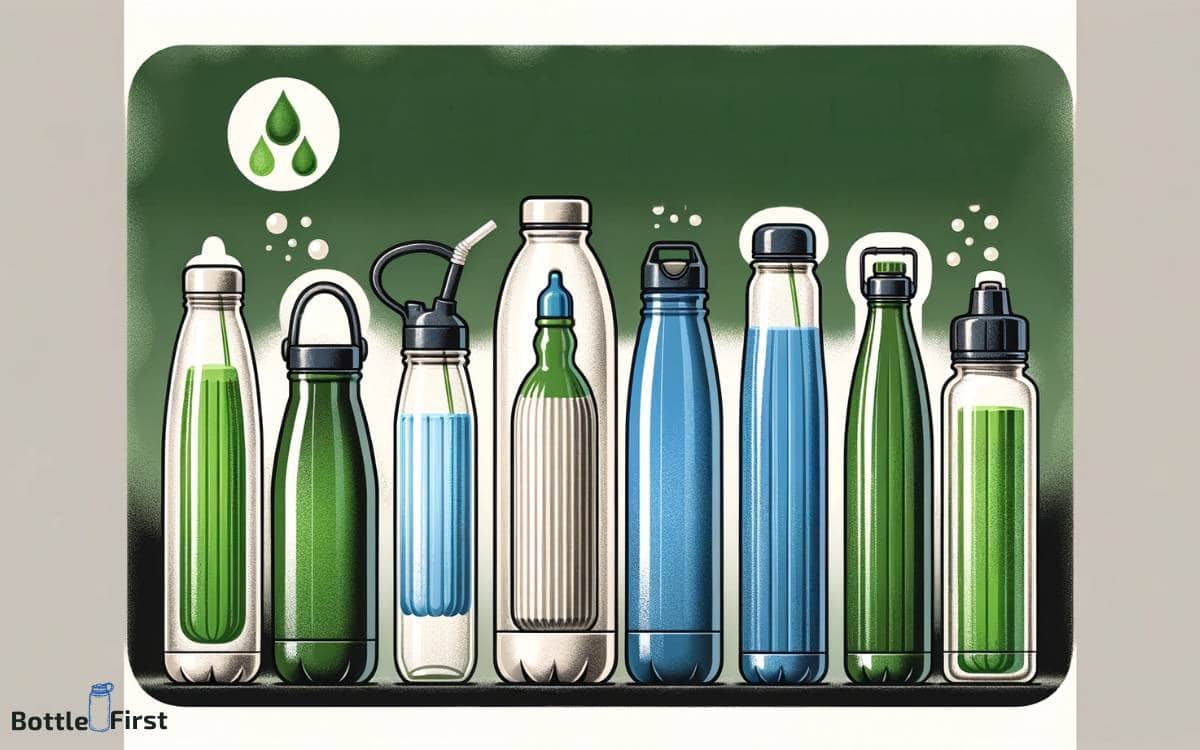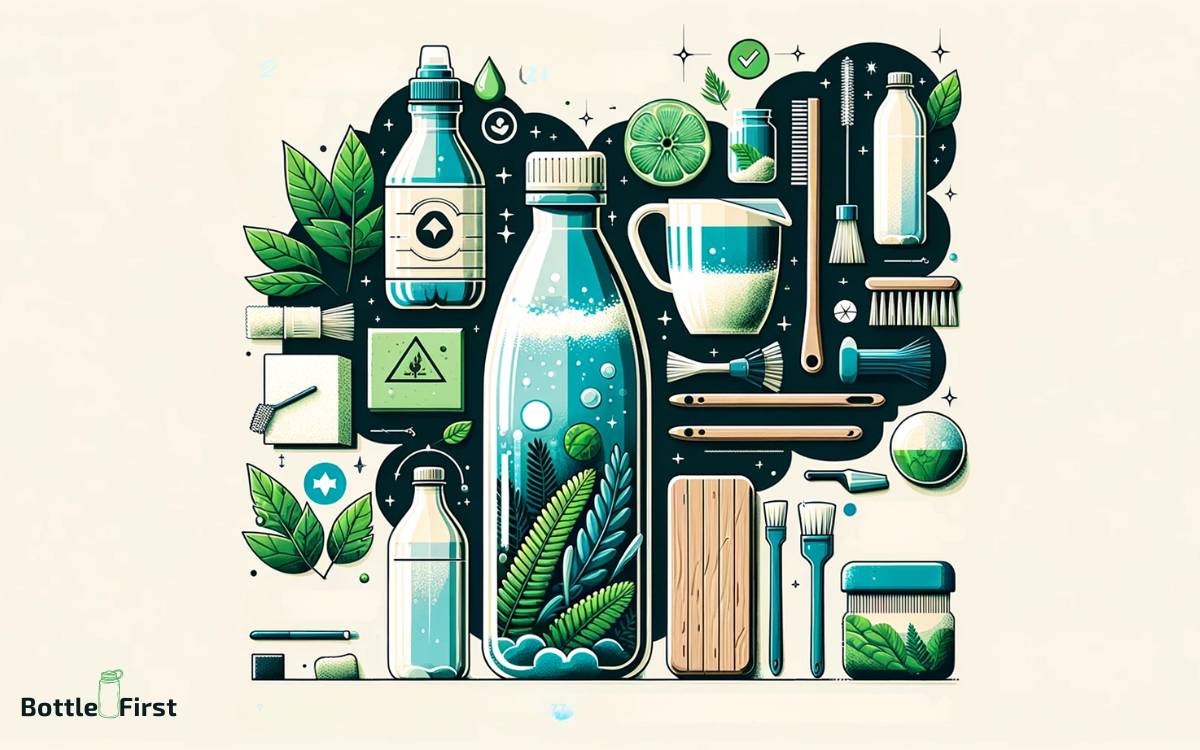What is the Green Stuff in My Water Bottle? Mold!
The green stuff in your water bottle is likely mold or algae, which can grow in moist environments where light and organic materials are present.
Mold and algae are common organisms that thrive in damp conditions and can accumulate in water bottles that are not regularly cleaned or dried out.
Here’s what you need to know about them:
Regular cleaning and drying are key to preventing the growth of mold or algae in your water bottle, ensuring your hydration is not only refreshing but also safe.
Key Takeaway
Common Causes and Solutions for Green Substances in Water Bottles
| Possible Causes | Description | Prevention/Solution |
|---|---|---|
| Algae | Algae is a simple nonflowering plant that typically grows in moist or wet environments. It can form in your water bottle especially if you leave it in a warm, well-lit place with water still inside. | Avoid leaving water bottles in warm, sunny areas. Clean your bottle thoroughly after each use. |
| Mold | Mold is a microscopic fungus that thrives in damp environments, such as a water bottle. It might appear as a slimy texture or small black specks in the bottle. | Wash your water bottles regularly, preferably every day, with hot water and soap. Dry completely before the next use. |
| Bacteria | Bacteria can accumulate from repeated usage of the water bottle, especially if not cleaned regularly. | Regular, thorough cleaning is required. Consider using a water bottle cleaning brush for hard-to-reach areas. |
| Mineral Deposits | If you fill your water bottle with tap water, it may contain minerals like calcium and magnesium. These minerals can leave behind greenish deposits, especially if the water is hard. | Regularly descale your water bottle with a mixture of vinegar and water. Rinse thoroughly before use. |
| Copper Oxidation | If your water bottle is made of copper, the green stuff might be copper oxide, which is naturally occurring due to oxidation. | Regularly clean your copper water bottle with a mixture of lemon and salt, then rinse with water. |
Understanding The Causes Of Green Residue
The green residue in your water bottle may be caused by algae growth, mineral deposits, or mold. Understanding the causes of this issue can help you keep your water bottle clean and safe to use.
Green residue in water bottles can be a puzzling sight, leaving many people wondering about its origins and potential health implications. If you’ve ever come across this green stuff, you’re not alone.
What Causes The Green Stuff In Water Bottles?
The development of green residue in water bottles can be attributed to multiple factors.
Let’s take a closer look at the key causes:
Minerals in the water: Certain minerals, such as copper, iron, and manganese, naturally occur in tap water.
When water sits in a bottle for an extended period, these minerals can react with the bottle’s plastic, resulting in the formation of a greenish residue.
Presence of bacteria: Bacteria, specifically algae, can find their way into your water bottle. Algae thrive in warm and moist environments, making water bottles a perfect breeding ground. Over time, the presence of algae can contribute to the green discoloration.
Exposure to sunlight: Continuous exposure to sunlight can accelerate the growth of algae and other bacteria in your water bottle.
Ultraviolet (uv) rays provide the ideal conditions for their proliferation, leading to the development of green residue.
Poor cleaning habits: Inadequate cleaning of water bottles can exacerbate the problem. When bottles aren’t thoroughly washed and dried after each use, any remaining water and organic matter provide a fertile ground for bacteria and algae to thrive.
Why Does It Develop Only In Water Bottles?
Curiously, green residue is predominantly found in water bottles rather than other containers.
This can be attributed to a couple of key reasons:
Environmental conditions: Water bottles provide a moist and enclosed environment, particularly when capped tightly.
This favorable setting allows for the accumulation of moisture and potentially contaminated substances, enabling the growth and proliferation of algae and bacteria.
Extended contact time: Unlike other containers, water bottles often remain in use for longer periods, with the potential for water being stored inside for hours or even days.
The extended contact time between water and the bottle’s surface increases the likelihood of mineral buildup and the growth of bacteria and algae.
Understanding the causes of green residue in water bottles can help you take preventive measures to keep your bottles clean and hygienic.
In the following sections, we will explore effective ways to remove and prevent this green stuff, ensuring you have a pleasant and worry-free drinking experience.
Effects Of Green Residue On Your Health
Discover the potential health effects of green residue in your water bottle and how it can impact your well-being. Understand the implications and take necessary precautions for a healthier lifestyle.
When you take a sip from your water bottle and notice a mysterious green residue, it’s natural to wonder about its impact on your health. Is this green gunk harmful, or is it just a harmless discoloration?
Remember, regularly cleaning and sanitizing your water bottle is crucial for maintaining good health.
Is The Green Gunk Harmful To Your Health?
- Ingesting the green residue from your water bottle can introduce harmful bacteria or mold into your body. This may lead to gastrointestinal issues such as nausea, vomiting, or diarrhea.
- The green gunk could contain algae, which can produce toxins that may pose a risk to your health. Ingesting these toxins can cause symptoms ranging from mild irritation to more severe health problems.
- Exposure to the green residue can also lead to respiratory issues, especially if mold or bacteria are present. Inhaling mold spores can trigger allergies or respiratory infections, impacting your overall well-being.
Potential Risks And Implications Of Ingesting Or Being Exposed To The Green Stuff:
- Bacterial contamination: the green residue might be a breeding ground for bacteria, such as coli or Staphylococcus aureus. These can cause infections and gastrointestinal issues.
- Mold growth: when the green gunk is actually mold, it can release spores that, when ingested or inhaled, may trigger allergic reactions or respiratory problems. This can be particularly concerning for individuals with underlying respiratory conditions.
- Toxin exposure: certain types of algae can produce toxins that are harmful to humans. Ingesting or inhaling these toxins can result in symptoms like headaches, dizziness, or even liver damage in severe cases.
Compromised immune system: consistently exposing yourself to the green residue can weaken your immune system, making you more susceptible to infections and illnesses.
The Importance Of Regularly Cleaning And Sanitizing Your Water Bottle:
- Cleaning your water bottle regularly ensures the removal of any potential green residue, mold, or bacteria that could harm your health.
- Properly sanitizing your water bottle eliminates harmful microorganisms, reducing the risk of contamination and associated health issues.
- Regular cleaning and sanitization also help maintain the taste and quality of the water you consume, providing a refreshing and enjoyable experience.
Remember, prevention is better than cure. Take proactive steps to clean your water bottle thoroughly, using appropriate cleaning agents and techniques.
By understanding the effects of green residue on your health, and by maintaining a clean and sanitized water bottle, you can ensure that each sip you take is not only refreshing but also safe for your well-being. Stay hydrated and stay healthy!
Preventing And Removing Green Residue
Green residue in your water bottle may be caused by the growth of algae or mold due to moisture and sunlight exposure.
To prevent and remove this green stuff, regularly clean your bottle with hot soapy water or use a mixture of vinegar and water for stubborn stains.
Tips For Preventing The Growth Of Green Residue In Water Bottles:
- Rinse your water bottle thoroughly after each use to remove any residual liquid or debris.
- Avoid leaving water sitting in your bottle for extended periods, as this can promote the growth of bacteria and algae.
- Store your water bottle in a cool and dry place, away from direct sunlight.
- Regularly clean your water bottle with hot water and a mild detergent or dish soap.
- Use a bottle brush or sponge to reach all areas of the bottle and scrub away any build-up.
- Consider using a water bottle with removable parts for easier cleaning.
- Replace your water bottle periodically, especially if it shows signs of damage or persistent residue.
Proper Cleaning Techniques To Remove The Green Gunk:
- Start by emptying your water bottle and rinsing it with warm water.
- Fill the bottle halfway with warm water and add a few drops of dish soap or a mixture of vinegar and water.
- Use a bottle brush or sponge to scrub the inside of the bottle, paying extra attention to areas with green residue.
- Rinse the bottle thoroughly with warm water to remove any soap or cleaning solution.
- For stubborn residue, try soaking the bottle in a mixture of warm water and baking soda or hydrogen peroxide.
- Rinse the bottle again to ensure all traces of cleaning agents are removed before using it.
The Role Of Cleaning Agents And Natural Solutions In Removing The Residue:
- Cleaning agents such as dish soap, vinegar, baking soda, and hydrogen peroxide can be effective in removing green residue from water bottles.
- Dish soap helps to break down oils and greasy build-up, while vinegar acts as a natural disinfectant.
- Baking soda has mild abrasive properties that can help scrub away tough stains and residue.
- Hydrogen peroxide is a powerful oxidizer that can eliminate bacteria and algae.
- When using cleaning agents, make sure to follow the instructions and dilute them properly, especially with food-grade items like water bottles.
- For a natural alternative, you can try using a mixture of lemon juice and hot water to remove the green gunk.
Remember, prevention is key to avoiding the growth of green residue in your water bottle.
Regular cleaning and proper maintenance will not only ensure your bottle stays clean but also help maintain your health and well-being. So, make it a habit to keep your water bottle fresh and residue-free.
Identifying Different Types Of Green Build-Up
Green build-up can appear in water bottles, and by identifying the different types, you can understand what it is.
This knowledge helps you to take appropriate actions to maintain your water bottle’s cleanliness and your health.
Distinguishing Between Algae And Mold Growth In Water Bottles
Algae and mold are common types of green build-up that can occur in water bottles. While they may look similar, there are some key differences that can help you identify which one you’re dealing with.
Here’s a breakdown:
Algae:
- Algae is a type of aquatic plant that thrives in moist environments, making water bottles an ideal breeding ground.
- It usually appears as a slimy green coating on the bottle’s surface.
- Algae growth is commonly accompanied by a noticeable foul odor.
- In some cases, you may even spot small green or brown spots floating in the water.
Mold:
- Mold, on the other hand, is a type of fungus that can grow in various conditions, including water bottles that aren’t properly cleaned or dried.
- Unlike algae, mold is usually fuzzy or powdery in texture and may have a darker green or blackish color.
- Mold growth in water bottles can also lead to a musty or unpleasant odor.
- In severe cases, you may even notice mold spores floating in the water.
By examining the appearance, texture, and odor of the green build-up, you can determine whether you’re dealing with algae or mold growth in your water bottle.
Remember that while both are unsightly, mold can pose health risks if ingested, so it’s important to take appropriate action if you discover mold in your water bottle.
Understanding The Characteristics And Appearances Of Different Green Substances
Green build-up in water bottles can take various forms, each with its own characteristics and appearance.
Here are some of the common green substances you may come across:
Algae:
- As mentioned earlier, algae present a slimy, green coating on the water bottle’s surface.
- It can be easily wiped off but may quickly reappear if the bottle isn’t properly cleaned and dried.
- Algae can range in color from light green to dark green and may even appear brown in some cases.
- In addition to the visual appearance, the foul odor accompanying algae growth is a characteristic feature.
Mold:
- Mold growth in water bottles often forms fuzzy or powdery patches.
- The color can vary from light green to dark green and may also appear blackish depending on the type of mold.
- Unlike algae, mold is more firmly attached to the bottle’s surface and can be difficult to remove completely.
- Musty or unpleasant odors are commonly associated with mold in water bottles.
Other green substances:
- There are other potential causes of green substances in water bottles, such as mineral deposits or residue from certain flavored drinks or supplements.
- Mineral deposits often appear as a powdery green or white residue that can usually be cleaned with vinegar or a mild cleaning solution.
- Residue from flavored drinks or supplements may also leave a greenish tint, but it is typically odorless and easily washed away.
Understanding the characteristics and appearances of different green substances can help you effectively identify and address the issue in your water bottle, ensuring safe and clean hydration.
How To Identify If The Green Stuff Is A Sign Of A Larger Problem
The green build-up in your water bottle may seem like a minor issue, but it can be a sign of a larger problem that requires attention.
Here are some indicators to help you identify if the green stuff is a sign of a more significant concern:
Persistent or rapid growth:
- If the green build-up continues to reappear rapidly after cleaning or grows back soon after removing it, it could indicate an underlying problem.
- This suggests that the conditions inside the water bottle, such as moisture or nutrients, are conducive to the growth of algae or mold.
Foul odor:
- A noticeable and persistent foul odor accompanying the green build-up is a red flag.
- It could indicate the presence of bacteria, mold, or other microorganisms that thrive in moist environments.
Health issues:
- If you notice any health issues, such as an upset stomach or recurring illnesses after using the water bottle, it may be linked to the green build-up.
- Mold, in particular, can cause allergic reactions, respiratory problems, and other health concerns when ingested.
Appearance of other colors:
- While green is the most common color associated with build-up in water bottles, the presence of other colors, such as black, brown, or pink, may suggest a more significant problem.
- Different colors can be indicative of different types of mold or bacteria that require specific remediation methods.
If you observe any of these signs, it’s important to address the issue promptly. Consider consulting a professional or replacing the water bottle to ensure your health and safety.
Remember, prevention and regular cleaning are key to avoiding future green build-up and potential problems.
Cleaning And Maintenance Best Practices
Discover effective cleaning and maintenance practices to tackle the mystery of the green stuff in your water bottle. Keep your bottle fresh and bacteria-free with these eco-friendly solutions.
Step-By-Step Guide To Cleaning Your Water Bottle Effectively:
- Rinse your water bottle with warm water, ensuring that all remnants of liquid are removed.
- Apply a few drops of dish soap to the bottle and use a bottle brush to scrub the interior, paying extra attention to the bottom and corners.
- Rinse the bottle thoroughly with warm water to remove any soap residue.
- To disinfect, mix equal parts water and white vinegar, then fill the bottle halfway with this solution.
- Allow the mixture to sit for at least 30 minutes before shaking it well to ensure all surfaces are exposed to the solution.
- Rinse the bottle thoroughly again with warm water to remove any vinegar smell.
- For hard-to-reach areas, use a cotton swab or a pipe cleaner to scrub the nooks and crannies.
- Leave the water bottle to air dry completely on a dish rack or with the cap off to prevent moisture buildup.
- Once dry, inspect the bottle for any residual odor or residue. If necessary, repeat the cleaning process.
The Importance Of Drying And Storing Your Water Bottle Properly:
- Proper drying: Ensure your water bottle is completely dry before storing it. This prevents the growth of bacteria and mold.
- Avoid sealing moisture: Keeping the cap off or slightly ajar allows air circulation, preventing stagnant moisture buildup.
- Store in a cool, dry place: Choose a location away from sunlight and humidity, as these conditions can promote bacterial growth.
- Avoid extreme temperatures: Do not expose your water bottle to extreme heat or cold, as this can cause damage and affect its usefulness.
- Storage hygiene: Prioritize cleanliness by wiping down the container’s exterior regularly, especially if exposed to dirt or contaminants.
Routine Maintenance Tips To Keep Your Water Bottle Free From Green Residue:
- Regular cleaning schedule: Clean your water bottle at least once a day or after each use to prevent the buildup of bacteria and residue.
- Handwashing is key: Avoid using the dishwasher, as high temperatures and harsh detergents can degrade the bottle’s materials and promote residue formation.
- Remove the cap and seal: Take apart your water bottle, including any detachable parts, for a thorough cleaning.
- Avoid certain beverages: Refrain from storing sugary drinks, juices, or carbonated beverages in your water bottle, as these can contribute to residue formation.
- Skip the long-term storage: Empty your water bottle between uses, especially if you won’t be using it for an extended period, to prevent the growth of microorganisms.
- Inspect for wear and tear: Regularly check your water bottle for any cracks, leaks, or signs of deterioration. Replace as necessary to maintain cleanliness and functionality.
Remember, proper cleaning and maintenance of your water bottle not only ensure the longevity of the container but also help keep you hydrated and healthy.
Alternative Water Bottle Options
Curious about the green stuff in your water bottle? Explore alternative options for cleaner hydration without worry. Discover eco-friendly and sustainable alternatives to traditional bottles.
Exploring Different Materials And Designs To Prevent Green Residue:
Stainless steel water bottles:
- Made of durable and corrosion-resistant stainless steel.
- Prevents the growth of bacteria and mold.
- Easy to clean and maintain.
- Keeps beverages hot or cold for extended periods.
- Some stainless steel bottles have a coating to enhance insulation.
Glass water bottles:
- Made from non-toxic and non-leaching glass.
- Preserve the taste and purity of water.
- Allows you to see the contents of the bottle.
- Generally easy to clean, but may be more fragile.
- Ideal for those concerned about chemical leaching from plastic.
Bpa-free plastic water bottles:
- Made from safe, non-toxic plastic without bisphenol-a (BPA).
- Lightweight and convenient for on-the-go use.
- Many styles and designs are available.
- Easy to clean, but may develop scratches over time.
- Suitable for those looking for an affordable and versatile option.
Pros And Cons Of Various Water Bottle Options In Relation To Green Gunk:
Stainless steel water bottles:
Pros:
- Resistant to corrosion and bacteria growth.
- Durable and long-lasting.
- Excellent at retaining temperature.
Cons:
- Some designs may have narrow openings that make cleaning difficult.
- Can be heavier than other options.
Glass water bottles:
Pros:
- Non-toxic and eco-friendly.
- Preserve the taste and quality of water.
- Easy to clean and sanitize.
Cons:
- Fragile and prone to breakage if dropped.
- Can be heavier than plastic or stainless steel bottles.
Bpa-free plastic water bottles:
Pros:
- Lightweight and portable.
- Wide range of styles and designs.
- Easy to clean and maintain.
Cons:
- Potential risk of chemical leaching over time.
- May develop scratches or discoloration.
Recommendations For Eco-Friendly And Easy-To-Clean Water Bottles:
Stainless steel water bottles:
- Choose bottles with a wide opening for easy cleaning.
- Look for bottles with a powder-coated finish for improved grip.
- Opt for double-walled insulation for superior temperature retention.
Glass water bottles:
- Select bottles with silicone sleeves for added protection against breakage.
- Look for bottles with wide mouths for effortless cleaning.
- Consider bottles with leak-proof lids for added convenience.
Bpa-free plastic water bottles:
- Make sure the plastic is marked as bpa-free.
- Look for bottles with removable parts for thorough cleaning.
- Choose bottles made from durable and dishwasher-safe plastic.
Remember, selecting the right water bottle is essential to avoid green residue and maintain the quality of your beverage.
Consider your priorities, such as durability, ease of cleaning, and eco-friendliness, when making your choice. With the right water bottle, you can stay hydrated in a safe and sustainable way.
Long-Term Solutions For Green Residue Prevention
Discover effective long-term solutions to prevent the green residue in your water bottle. Say goodbye to the mysterious green stuff with these easy-to-implement strategies for clean and fresh hydration.
Understanding The Importance Of Regular Deep Cleaning
- Regular deep cleaning of water bottles is key to preventing the formation of green residue.
- Green residue is often caused by a buildup of bacteria, mold, or algae in the bottle.
- By thoroughly cleaning your water bottle on a consistent basis, you can ensure that these contaminants are removed, reducing the chances of green residue formation.
Adopting Good Hygiene Practices To Prevent Green Residue Formation
Practicing good hygiene habits can go a long way in preventing the formation of green residue in your water bottle.
- Wash your water bottle with warm, soapy water after each use: This helps to remove any leftover residue or bacteria that may be present.
- Pay special attention to crevices and hard-to-reach areas: Use a bottle brush or a toothbrush to scrub these areas thoroughly.
- Rinse the bottle thoroughly: Make sure to rinse away all soap residue before refilling your water bottle.
- Dry the bottle completely before storing it: Moisture can promote the growth of bacteria, so it’s crucial to let your bottle air dry before putting it away.
Seeking Professional Advice For Persistent Green Residue Issues
If you continue to experience persistent green residue issues despite adopting good hygiene practices, it may be time to seek professional advice.
- Consult a water bottle expert: Reach out to someone who specializes in water bottle maintenance for personalized advice.
- Consider using cleaning agents: Some cleaning agents specifically designed for water bottles can help eliminate stubborn green residue. However, ensure they are safe for use in your specific bottle material.
- Explore alternative bottle options: If green residue continues to be an ongoing problem, you may want to consider switching to a different type of water bottle material that is less prone to residue formation.
Remember, taking proactive steps to prevent green residue formation is essential for maintaining a hygienic and safe drinking experience.
Regularly deep cleaning your water bottle and adopting good hygiene practices can go a long way in keeping green residue at bay.
Conclusion
After understanding the green stuff in your water bottle, it is important to take proactive measures to ensure your health and wellbeing.
Regularly cleaning and sanitizing your water bottle can help prevent the growth of bacteria and algae.
Consider using a brush and mild detergent to scrub the inside of your bottle, paying special attention to any crevices or corners where residue may accumulate.
Additionally, storing your water bottle in a cool and dry place can discourage the growth of mold and mildew.
It is also recommended to replace your water bottle regularly, especially if you notice any discoloration, unusual odor, or persistent green residue.
By taking these steps, you can keep your water bottle clean, safe, and free from any unwanted green substances, allowing you to enjoy pure and refreshing hydration wherever you go.
FAQ About What Is The Green Stuff In My Water Bottle
Is It OK to Drink Water With Algae?
Drinking water with algae is not recommended.
How Do You Get Green Fungus Out Of A Water Bottle?
To remove green fungus from a water bottle, follow these steps:
1. Empty the bottle and rinse it thoroughly with warm water.
2. Mix equal parts of white vinegar and water in the bottle.
3. Close the bottle tightly and shake it vigorously for a few minutes.
4. Let the vinegar mixture sit in the bottle for about 15 minutes.
5. Scrub the inside of the bottle using a bottle brush or a sponge.
6. Rinse the bottle thoroughly with warm water to remove any remaining fungus or vinegar smell.
7. Leave the bottle open to air dry completely before using it again.
Regularly cleaning your water bottle by following these steps can help prevent the growth of fungus and ensure a clean and hygienic drinking experience.
What Is The Green Slimy Stuff In The Water?
The green slimy stuff in the water is usually algae, which are simple aquatic plants.
Algae can form in stagnant or nutrient-rich water and thrive in warm temperatures and sunlight.
Algae blooms are common in ponds, lakes, and other bodies of water, creating a greenish or slimy appearance on the surface.
These blooms are not only unsightly but can also harm the ecosystem by depleting oxygen levels and blocking sunlight.
To prevent algae growth, it is important to maintain good water quality by reducing nutrient run-off from fertilizers or organic matter.
Proper water circulation and filtration can also help control algae growth. Regularly removing debris and maintaining a balanced ph can further discourage the growth of algae in water bodies.
Why Is There Gunk In My Water Bottle?
Gunk in water bottles can be caused by bacterial growth and mineral deposits. Bacteria thrive in warm, moist environments like water bottles.
When these bottles aren’t properly cleaned and dried, bacteria multiply and create a slimy film or gunk.
Mineral deposits, such as calcium and magnesium from hard water, can also accumulate in bottles over time.
This buildup appears as white or brownish flakes or sediment in the water. To prevent gunk in your water bottle, make sure to wash it regularly with warm soapy water, rinse it thoroughly, and let it air dry completely.
Consider using a bottle brush or vinegar to remove stubborn mineral deposits.
Moreover, storing bottles in a clean and dry place can help prevent bacterial growth.
What Causes Green Stuff To Form In Water Bottles?
The green stuff in water bottles is caused by the growth of algae or mold due to moisture and contaminants present in the bottle.
